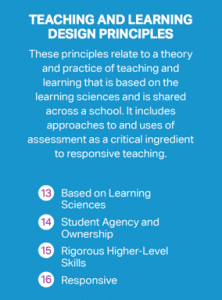4 Teaching and Learning Design Principles to Ensure High-Quality Competency-Based Systems
Education Domain Blog
This is the ninth post in the blog series on the report, Quality and Equity by Design: Charting the Course for the Next Phase of Competency-Based Education.
What does high-quality teaching and learning look like in competency-based schools?
Competency-based schools create a shared understanding of teaching and learning based on the learning sciences to create a high-quality system that ensures each child’s success.
There is no one right instructional method in competency-based schools, although there are implications for instruction and assessment with regards to using evidence from the learning sciences.
In a previous blog in this series, we introduced 16 Quality Design Principles as a common reference point for dialogue about what makes a competency-based system high quality. The 16 Quality Design Principles are organized into three categories: Culture, Structure, and Teaching and Learning. In this blog, we explore the 4 Teaching and Learning Design Principles.
4 Quality Design Principles for Teaching and Learning
These principles relate to a theory and practice of teaching and learning that is based in research and is shared across a school.
 1. Base School Design And Pedagogy On Learning Sciences
1. Base School Design And Pedagogy On Learning Sciences
Competency-based systems leverage a variety of instructional approaches. There is not a preferred approach. Whatever the approach, it must be explicit, shared and grounded in research about learning, motivation and engagement. Responding effectively within a student’s zone of proximal development necessitates a well-developed understanding of effective practices. Pedagogy includes approaches to and uses of assessment as critical ingredients to responsive teaching.
 2. Activate Student Agency And Ownership
2. Activate Student Agency And Ownership
Cultivating agency, the ability to direct one’s course in life, is a core objective of quality competency-based schools. Like any other skill, mastery necessitates practice. Competency-based schools support students’ agency by seeking out opportunities for students to inform and ultimately lead their own learning trajectory. With gradual release, students have expanded opportunities for practicing habits of success, self-direction and choice. The school’s culture of growth enables these learning experiences to be positive rather than opportunities for failure.
 3. Design For The Development Of Rigorous Higher-Level Skills
3. Design For The Development Of Rigorous Higher-Level Skills
Quality requires not only that students master content but that they have opportunities to apply their learning to different contexts. This enables them to engage in deeper learning and build higher level skills. It also depends upon learning that regularly involves productive struggle. Productive struggle, in turn, reinforces a student’s sense of agency and creates opportunities to persevere until new learning emerges. As a result, students have the opportunity to apply their learning and engage in building higher-order skills. Instruction, learning experiences and assessment, including performance-based assessments, are designed to create these learning experiences.
Instructional support, learning experiences, time, resources, place, tools and technology are organized and deployed based on interests and needs of students. Many educators differentiate teaching and learning strategies in order to help students access content more readily. In a quality competency-based school, differentiation goes beyond accessing content to adjusting pace, format and medium so that the prerequisite skills are mastered. These adjustments take into consideration a student’s emotional and academic development (zone of proximal development).
Follow this blog series for more articles charting the course for the next phase of competency-based education, or download the full report:
- CompetencyWorks Releases New Report on Quality and Equity by Design: Charting the Course for the Next Phase of Competency-Based Education
- Readiness for College, Career and Life: The Purpose of K-12 Public Education Today
- Why A Competency-Based System Is Needed: 10 Ways the Traditional System Contributes to Inequity
- How Competency-Based Education Differs from the Traditional System of Education
- Competency-Based Education and Personalized Learning Go Hand-In-Hand
- Building Shared Understanding of Quality through Design Principles
- 5 Quality Design Principles for Culture in Personalized, Competency-Based Systems
- Structure Design Principles to Ensure High-Quality Competency-Based Systems
